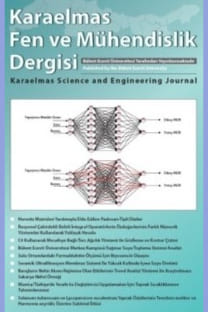Manyetik Kalkan Alaşımları Ni80Fe15Mo5 ve Ni77Fe14Cu5Mo4’ün 15keV-100GeV Enerji Aralığında Foton Zayıflatma Parametrelerini Belirleyerek Radyasyon Zırhlama Özellikleri Üzerine Teorik Bir Çalışma
Bu çalışmada, manyetik kalkan alaşımları olarak bilinen Ni80Fe15Mo5 ve Ni77Fe14Cu5Mo4’ün foton-madde etkileşim parametrelerini
hesaplamayı amaçladık. Parametreler Phy-X / PSD yazılımı kullanılarak belirlendi. Alaşımların 15keV ve 100GeV foton enerjileri
arasında radyasyon zırhlama potensiyellerinin belirlenmesi için kütle zayıflatma katsayısı, doğrusal zayıflatma katsayısı, efektif atom
numarası, yarı kalınlık değeri, onda birine düşürme değeri, toplam atomik tesir kesiti ve toplam elektronik tesir kesiti gibi radyasyon
zayıflatma parametreleri hesaplanmıştır. Alaşımların zırhlama potansiyelleri, daha önce bildirilmiş yaygın olarak kullanılan zırhlama
malzemelerinin potansiyelleriyle karşılaştırılmıştır.
Anahtar Kelimeler:
Radyasyon zayıflatma katsayısı, Radyasyon zırhlama, Manyetik zırhlama alaşımları
A Theoretical Study on Radiation Shielding Characteristics of Magnetic Shielding Alloys, Ni80Fe15Mo5 and Ni77Fe14Cu5Mo4, by Determining the Photon Attenuation Parameters in the Energy Range of 15keV-100GeV
In this study, we aimed to calculate photon-matter interaction parameters of Ni80Fe15Mo5 and Ni77Fe14Cu5Mo4, which are known as
magnetic shielding alloys. The parameters were determined by using Phy-X/PSD software. The radiation attenuation parameters such
as mass attenuation coefficient, linear attenuation coefficient, effective atomic number, half-value layer, tenth-value layer, total atomic
cross section and total electronic cross section were calculated between the photon energies 15keV and 100GeV in order to determine
the radiation shielding potentials of the alloys. The shielding potentials of the alloys were compared with those of widely used shielding
materials reported before.
___
- 1. Reference1 Akkaş, A. 2016. Determination of the Tenth and Half Value Layer Thickness of Concretes with Different Densities. Acta Physica Polonica A, 129: 770-772. https://doi.org/10.12693/APhysPolA.129.770
- 2. Reference2 Akkurt, I. and Tekin, H.O. 2020. Radiological parameters of bismuth oxide glasses using the Phy-X/PSD software. Emerging Mater. Res., 9: 1020-1027. https://doi.org/10.1680/jemmr.20.00209
- 3. Reference3 Alım, B., Şakar, E., Özpolat, Ö.F., Han, I. &Demir, L. 2019. Determination of Gamma Photon Protection Capability of Ni77Fe14Cu5Mo4: A Magnetic Shielding Alloy. 4th Inter. Conf. Adv. Natural & Appl. Scı. Phys., 266-276.
- 4. Reference4 Alım, B. 2020a. Determination of Radiation Protection Features of the Ag2O Doped Boro-Tellurite Glasses Using Phy-X / PSD Software. J. Inst. Sci.Tech., 10(1): 202-213. https://doi.org/10.21597/jist.640027
- 5. Reference5 Alım, B. 2020b. A comprehensive study on radiation shielding characteristics of Tin Silver, Manganin R, Hastelloy B, Hastelloy X and Dilver P alloys. Applied Physics A, 126:262. https://doi.org/10.1007/s00339-020-3442-7
- 6. Reference6 Aygun, Z. 2018. Application of Spectroscopic Methods for Analysis of Ni-Based Alloys (Ni% ≥70). Cumhuriyet Sci. J., 39: 144-151. https://doi.org/10.17776/csj.405681
- 7. Reference7 Bashter, II. 1997. Calculation of radiation attenuation coefficients for shielding concretes. Ann. Nucl. Energy 24(17): 1389-1401.https://doi.org/10.1016/S0306-4549(97)00003-0
- 8. Reference8Han, I. and Demir, L. 2009a. Determination of mass attenuation coefficients, effective atomic and electron numbers for Cr, Fe and Ni alloys at different energies. Nucl. Instr. Methods B, 267: 3–8. https://doi.org/10.1016/j.nimb.2008.10.004
- 9. Reference9 Han, I. and Demir, L. 2009b. Studies on effective atomic numbers, electron densities from mass attenuation coefficients in TixCo1-x and CoxCu1-x alloys. Nucl. Instr. Methods B, 267: 3505–3510. https://doi.org/10.1016/j.nimb.2009.08.022
- 10. Reference10 Han, I. and Demir, L. 2010. Studies on effective atomic numbers, electron densities and mass attenuation coefficients in Au alloys. J. X-ray Sci. Tech., 18: 39–46. https://doi.org/10.3233/XST-2010-0238
- 11. Reference11 Jackson, DF. & Hawkes, DJ. 1981. X-ray attenuation coefficients of elements and mixtures. Phys. Reports, 70: 169–233.https://doi.org/10.1016/0370-1573(81)90014-4
- 12. Reference12 Issa, SAM. and Mostafa, AMA. 2017. Effect of Bi2O3in borate-tellurite-silicate glass system for development of gamma-rays shielding materials. J. Alloys Comp., 695: 302-310. https://doi.org/10.1016/j.jallcom.2016.10.207
- 13. Reference13 Kulali, F. 2020. Simulation studies on the radiological parameters of marble concrete. Emerging Mater. Res., 9: 1341-1347. https://doi.org/10.1680/jemmr.20.00307 14. Reference14Kurudirek, M., Türkmen, I. and Özdemir, Y. 2009. A study of photon interaction in some building materials: High-volume admixture of blast furnace slag into Portland cement. Radiat. Phys. Chem., 78: 751–759. https://doi.org/10.1016/j.radphyschem.2009.03.070
- 15. Reference15 Manjunatha, HC. 2017. A study of gamma attenuation parameters in poly methyl methacrylate and Kapton. Radiat. Phys. Chem., 137: 254–259. https://doi.org/10.1016/j.radphyschem.2016.01.024
- 16. Reference16 Mann, KS., Kaur, B., Sidhu, GS. and Kumar, A. 2013. Investigations of some building materials for g-rays shielding effectiveness. Radiat. Phys. Chem., 87: 16-25. https://doi.org/10.1016/j.radphyschem.2013.02.012
- 17. Reference17 Olekšáková, D., Kollár, P., Jakubcin, M., Slovenský, P., Bircáková, Z., Füzer, J., Fáberová, M. and Bureš, R. 2020. Anhysteretic Magnetization for NiFeMo Soft Magnetic Compacted Powder. Acta Physica Polonica A, 137: 899-891. https://doi.org/10.12693/APhysPolA.137.889
- 18. Reference18 Şakar, E., Özpolat, ÖF., Alım, B., Sayyed, MI. and Kurudirek, M. 2020. Phy-X / PSD: Development of a user friendly online software for calculation of parameters relevant to radiation shielding and dosimetry. Radiat. Phys. Chem., 166: 1-12. https://doi.org/10.1016/j.radphyschem.2019.108496
- 19. Reference19 Yılmaz, D., Boydaş, E. and Cömert, E. 2016. Determination of mass attenuation coefficients and effective atomic numbers for compounds of the 3d transition elements. Radiat. Phys. Chem., 125: 65–68. https://doi.org/10.1016/j.radphyschem.2016.03.014 Ek Bilgiler Editöre Yorumunuz
- ISSN: 2146-4987
- Yayın Aralığı: Yılda 2 Sayı
- Başlangıç: 2011
- Yayıncı: ZONGULDAK BÜLENT ECEVİT ÜNİVERSİTESİ
Sayıdaki Diğer Makaleler
Nafyon-Grafenle Modifiye Edilmiş Camsı Karbon Elektrot ile Pendimethalinin Voltametrik Tayini
Akpınar (Kırşehir) Bölgesi Nefelinli Siyenitinin Teknolojik Özelliklerinin Araştırılması
Kabak Çekirdeği Yağının Kompleks Koaservasyon Yöntemi ile Mikroenkapsülasyonu
Okan Bayram, Elif Köksal, Fethiye Göde, Emel Moral, Fatma Danaş
Kare Silindir Etrafında Akış ve Tümleşik Taşınım ile Isı Geçişi
38 Atomlu Ni-Pt-Cu Üçlü Nanoalaşımlarının Yapısal ve Dinamik Özellikleri
